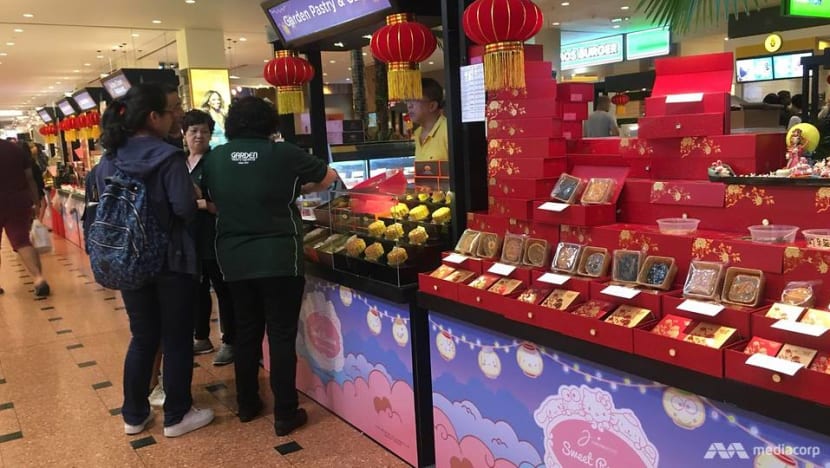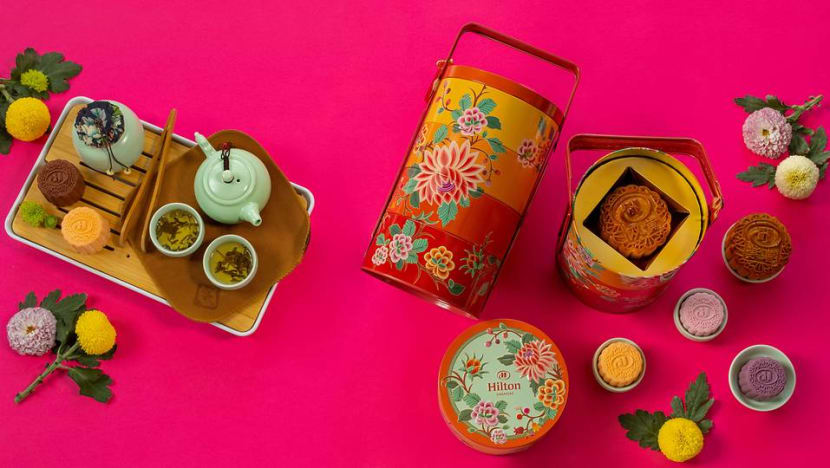Elaborate mooncake packaging difficult to recycle and damaging to the environment, experts say

Stalls selling mooncakes at a shopping mall in Singapore. (File Photo: Ang Hwee Min)
SINGAPORE: Every Mid-Autumn Festival, many in Singapore buy and gift mooncakes to celebrate the occasion. Most of them come enclosed in fancy boxes, with colourful and lacquered packaging.
And each year, the mooncakes seem to come in more extravagant packaging. But as these retailers compete to win over consumers with the most extravagant designs, the resulting packaging waste from these mooncake boxes can be harmful to the environment, said experts.
About 40 per cent of the packaging is unnecessary and wasteful, said Mr Liow Chean Siang, head of environmental certifications at the Singapore Environment Council (SEC).
He added: “Over the years, packaging for mooncakes has become so much more elaborate and fancy, resulting in more paper and plastic being used. Besides the presentation box itself, more plastic and paper are also used for the inner packaging to keep each mooncake in place to prevent spoilage, contamination and damage during transportation.
“All this adds up to more waste being generated than necessary.”
READ: The Indonesian village being buried by the developed world’s waste
A spokesman from Tay Paper Recycling told CNA that it receives slightly less than five tonnes of paper and cardboard waste from mooncake boxes every year. Tay Paper Recycling is one of the major paper recycling companies in Singapore; it processes about 5,000 to 8,000 tonnes of waste paper monthly.
He added that mooncake boxes can be difficult to recycle due to the laminate that makes the boxes glossy. “We generally do not accept them. There is not much we can do but to send them for incineration.”
And each tonne of paper used is equivalent to 17 trees, said Mr Liow.
“With the growth of green consumerism, we have the power to say no to elaborate packaging, and send a clear message to manufacturers to reduce product packaging to a minimum and cut down on unnecessary wastage,” he added.
“If we can reduce paper consumption, we can reduce the number of trees from being cut down.”
Commentary: Recycling makes you feel less guilty but doesn’t change how huge our plastic problem is
Mooncake retailers CNA spoke to acknowledged that mooncake packaging can be made more environmentally friendly, but also highlighted the importance of design and food safety.
Mr Cavaliere Giovanni Viterale, general manager of Fullerton Hotels and Resorts, said their mooncakes this year are packed in cardboard boxes which are “95 per cent recyclable and 100 per cent reusable”.
“The team designed the boxes such that they can be repurposed and reused. Our premium boxes are designed to be reused as jewellery boxes. Our limited edition boxes, meanwhile, are collectibles. This year’s edition is designed as a carry case with a mirror, perfect for reuse as a beauty kit.”
He added that the team is currently exploring a fully recyclable mooncake box for next year, but highlighted that retailers have to strike a balance between reducing packaging waste and ensuring quality, food safety and hygiene.

A Hilton Singapore spokesman said the team “worked closely” with its packaging supplier to create a mooncake box that is recyclable, reusable and can be repurposed for other uses.
The hotel’s mooncakes come in a four-tier round floral embossed tiffin carrier made from 100 per cent fully recyclable, food-safe aluminium material, meant to be repurposed as a takeaway food carrier, he said.
The spokesman also highlighted that the team is considering using food-grade paper instead of plastic packaging when wrapping individual mooncakes.
READ: 7 in 10 people in Singapore do not know what plastics to recycle: SEC report
READ: Singapore shoppers take 820 million plastic bags from supermarkets each year
Chairman of the Packaging Council of Singapore Betty Tan said it may be difficult for retailers to avoid fanciful packaging.
“The trend now is to give these mooncakes as a gift. In order to attract consumers to purchase these mooncakes, the presentation and marketing must be eye-catching. And the only way to do this is to have attractive packaging to gift wrap these mooncakes,” she added.
USING LESS IS STILL BEST
Mr Liow believes “using less is still the best”, adding that the SEC strongly believes that reducing usage is always preferred over reusing and recycling.
“Packaging should be functional. If retailers and manufacturers need to make it more fancy, then one way is to design the boxes to have dual use, which some are already doing, but it is still not preferred as additional resources are used,” he added.
Ms Melissa Tan, chairman of the Waste Management & Recycling Association of Singapore, agreed that manufacturers should cut down on unnecessary packaging because not everything can be recycled.
“Most of the packaging can be recycled as long as it is not contaminated by food waste like remnants of mooncakes and oil stains, and the paper or cardboard is not covered by a layer of glossy varnish or waterproof wax,” she added.
“Besides contributing to less generation of waste, the manufacturers should let the quality of their products speak for themselves to attract customers, rather than the design of the packaging. The outward appearance of the product should be decent, but it need not be ostentatious and ultimately, wasteful.”
READ: The monstrous scale of plastic bag wastage in Singapore
READ: "Cannot sell ... so they burn" – what’s next in the uncertain future for plastic waste in Singapore?
It “would be ideal” if consumers could peel off the laminate before sending their unwanted mooncake boxes for recycling, said the spokesman for Tay Paper recycling.
"Remove all non-paper materials such as plastic stickers, laminate, cushioning materials. Manufacturers could adopt a package labelling scheme similar to the one in Australia to better indicate if the packaging is recyclable or if steps are needed before sending them for recycling,” he added.
Mr Liow said: “Eating mooncakes used to be a delicacy eaten once a year as part of the tradition of the Mid-Autumn Festival. Over the years, the custom seems to have changed. Today, buying expensive mooncakes is often about gifting to impress someone and not about the festival, for example, given as corporate gifts by businesses to their clients.
“Let us start to do our part for the environment by being more conscious of our consumption and voice it out through our choice of purchases.”












